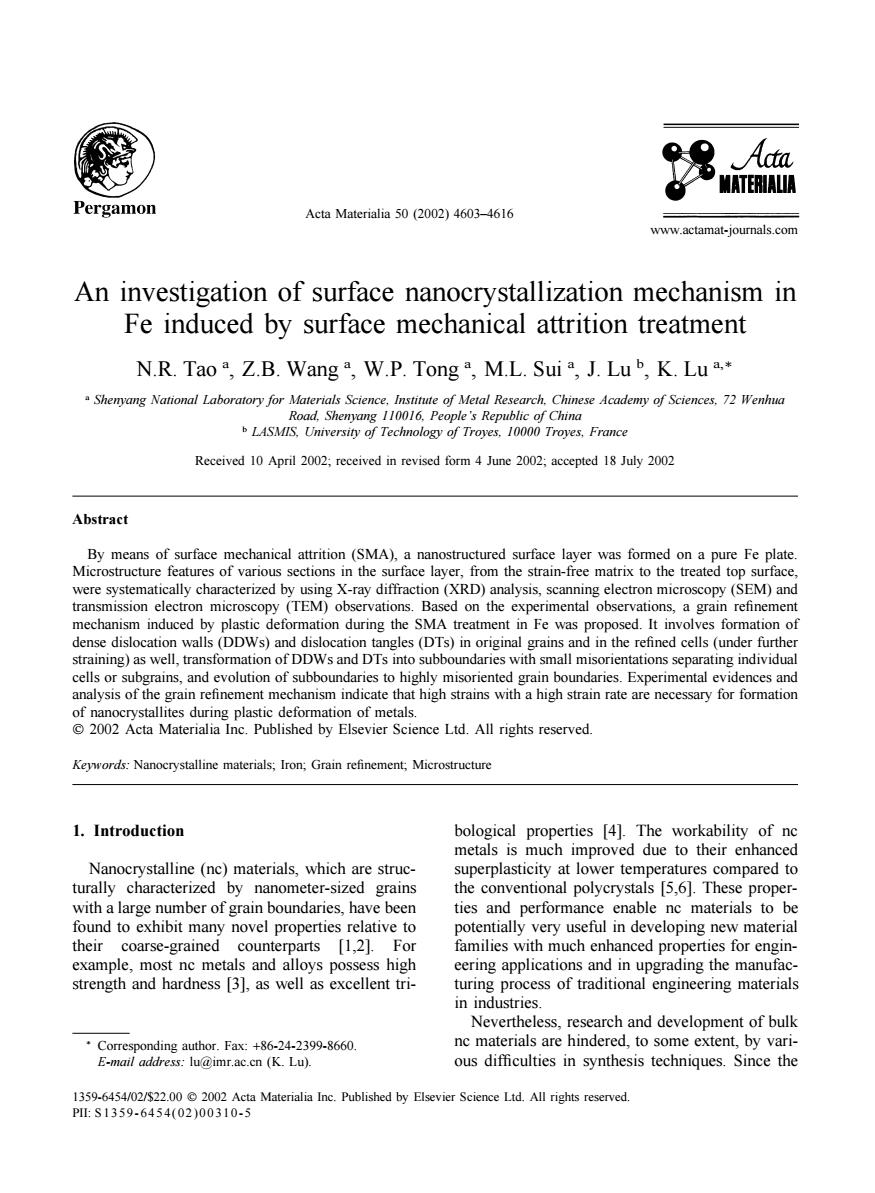正在加载图片...

cta MATERIALIA Pergamon Acta Materialia 50(2002)4603-4616 www.actamat-journals.com An investigation of surface nanocrystallization mechanism in Fe induced by surface mechanical attrition treatment N.R.Tao",Z.B.Wang",W.P.Tong,M.L.Suia,J.Lu b,K.Lu a* .Shenyang National Laboratory for Materials Science,Institute of Metal Research.Chinese Academy of Sciences.72 Wenhua Road.Shenyang 110016.People's Republic of China LASMIS.University of Technology of Troyes.10000 Troyes.France Received 10 April 2002;received in revised form 4 June 2002;accepted 18 July 2002 Abstract By means of surface mechanical attrition (SMA),a nanostructured surface layer was formed on a pure Fe plate Microstructure features of various sections in the surface layer,from the strain-free matrix to the treated top surface, were systematically characterized by using X-ray diffraction(XRD)analysis,scanning electron microscopy(SEM)and transmission electron microscopy (TEM)observations.Based on the experimental observations,a grain refinement mechanism induced by plastic deformation during the SMA treatment in Fe was proposed.It involves formation of dense dislocation walls(DDWs)and dislocation tangles(DTs)in original grains and in the refined cells(under further straining)as well,transformation of DDWs and DTs into subboundaries with small misorientations separating individual cells or subgrains,and evolution of subboundaries to highly misoriented grain boundaries.Experimental evidences and analysis of the grain refinement mechanism indicate that high strains with a high strain rate are necessary for formation of nanocrystallites during plastic deformation of metals. 2002 Acta Materialia Inc.Published by Elsevier Science Ltd.All rights reserved. Keywords:Nanocrystalline materials;Iron;Grain refinement;Microstructure 1.Introduction bological properties [4].The workability of nc metals is much improved due to their enhanced Nanocrystalline (nc)materials,which are struc- superplasticity at lower temperatures compared to turally characterized by nanometer-sized grains the conventional polycrystals [5,6].These proper- with a large number of grain boundaries,have been ties and performance enable nc materials to be found to exhibit many novel properties relative to potentially very useful in developing new material their coarse-grained counterparts [1,2].For families with much enhanced properties for engin- example,most nc metals and alloys possess high eering applications and in upgrading the manufac- strength and hardness [3],as well as excellent tri- turing process of traditional engineering materials in industries. Nevertheless,research and development of bulk Corresponding author.Fax:+86-24-2399-8660. nc materials are hindered,to some extent,by vari- E-mail address:lu@imr.ac.cn (K.Lu). ous difficulties in synthesis techniques.Since the 1359-6454/02/$22.00 2002 Acta Materialia Inc.Published by Elsevier Science Ltd.All rights reserved. Pl:S1359-6454(02)00310-5Acta Materialia 50 (2002) 4603–4616 www.actamat-journals.com An investigation of surface nanocrystallization mechanism in Fe induced by surface mechanical attrition treatment N.R. Tao a , Z.B. Wang a , W.P. Tong a , M.L. Sui a , J. Lu b , K. Lu a,∗ a Shenyang National Laboratory for Materials Science, Institute of Metal Research, Chinese Academy of Sciences, 72 Wenhua Road, Shenyang 110016, People’s Republic of China b LASMIS, University of Technology of Troyes, 10000 Troyes, France Received 10 April 2002; received in revised form 4 June 2002; accepted 18 July 2002 Abstract By means of surface mechanical attrition (SMA), a nanostructured surface layer was formed on a pure Fe plate. Microstructure features of various sections in the surface layer, from the strain-free matrix to the treated top surface, were systematically characterized by using X-ray diffraction (XRD) analysis, scanning electron microscopy (SEM) and transmission electron microscopy (TEM) observations. Based on the experimental observations, a grain refinement mechanism induced by plastic deformation during the SMA treatment in Fe was proposed. It involves formation of dense dislocation walls (DDWs) and dislocation tangles (DTs) in original grains and in the refined cells (under further straining) as well, transformation of DDWs and DTs into subboundaries with small misorientations separating individual cells or subgrains, and evolution of subboundaries to highly misoriented grain boundaries. Experimental evidences and analysis of the grain refinement mechanism indicate that high strains with a high strain rate are necessary for formation of nanocrystallites during plastic deformation of metals. 2002 Acta Materialia Inc. Published by Elsevier Science Ltd. All rights reserved. Keywords: Nanocrystalline materials; Iron; Grain refinement; Microstructure 1. Introduction Nanocrystalline (nc) materials, which are structurally characterized by nanometer-sized grains with a large number of grain boundaries, have been found to exhibit many novel properties relative to their coarse-grained counterparts [1,2]. For example, most nc metals and alloys possess high strength and hardness [3], as well as excellent tri- ∗ Corresponding author. Fax: +86-24-2399-8660. E-mail address: lu@imr.ac.cn (K. Lu). 1359-6454/02/$22.00 2002 Acta Materialia Inc. Published by Elsevier Science Ltd. All rights reserved. PII: S 13 59 -6454(02)00310-5 bological properties [4]. The workability of nc metals is much improved due to their enhanced superplasticity at lower temperatures compared to the conventional polycrystals [5,6]. These properties and performance enable nc materials to be potentially very useful in developing new material families with much enhanced properties for engineering applications and in upgrading the manufacturing process of traditional engineering materials in industries. Nevertheless, research and development of bulk nc materials are hindered, to some extent, by various difficulties in synthesis techniques. Since the